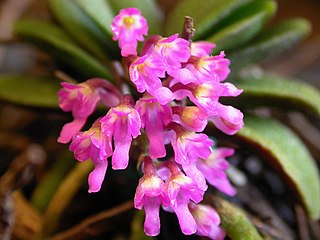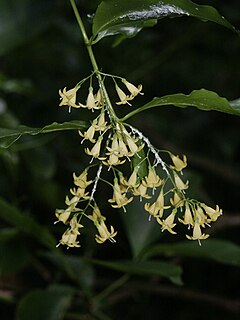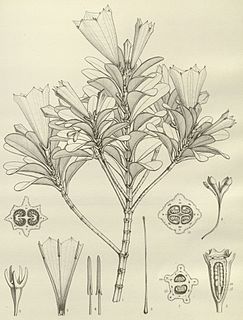
Homalanthus is a plant genus of the family Euphorbiaceae first described as a genus in 1824. It is the only genus in subtribe Carumbiinae. The genus is native to tropical Asia, Australia, and various islands in the Pacific.

Dysoxylum is a flowering plant genus of trees and shrubs from the mahogany family, Meliaceae.

Barringtonia is a genus of flowering plants in the family Lecythidaceae first described as a genus with this name in 1775. It is native to Africa, southern Asia, Australia, and various islands of the Pacific and Indian Oceans. The genus name commemorates Daines Barrington.
Neuburgia is a genus of plants in the family Loganiaceae. It is native to the Bismarck Archipelago, Caroline Islands, Fiji, Maluku Islands, New Caledonia, New Guinea, Philippines, Solomon Islands, Sulawesi, and Vanuatu. It contains the following species :

Ochrosia is a genus of flowering plants, first described in 1789. It is in the family Apocynaceae, native to Southeast Asia, Australia, and various islands of the Indian and Pacific Oceans.
- Ochrosia ackeringae(Teijsm. & Binn.) Miq. – Indonesia, Philippines, Papuasia, Christmas Island
- Ochrosia acuminataTrimen ex Valeton - Sulawesi
- Ochrosia alyxioidesGuillaumin - Vanuatu
- Ochrosia apoensisElmer - Luzon, Mindanao
- Ochrosia balansae(Guillaumin) Baill. ex Guillaumin - New Caledonia
- Ochrosia basistaminaHendrian - Sulawesi
- Ochrosia bodenheimarumGuillaumin - Vallée de la Toutouta in New Caledonia
- Ochrosia borbonicaJ.F.Gmel. – Mauritius + Réunion; naturalized in Guangdong
- Ochrosia brevitubaBoiteau - New Caledonia
- Ochrosia brownii(Fosberg & Sachet) Lorence & Butaud - Nuku Hiva in Marquesas
- Ochrosia citrodoraK.Schum. & Lauterb. - New Guinea
- Ochrosia coccinea(Teijsm. & Binn.) Miq. - Maluku, Sulawesi, New Guinea, Solomon Islands; naturalized in Guangdong
- Ochrosia comptaK.Schum., Hōlei – Hawaii
- Ochrosia ellipticaLabill. – Lord Howe Island, Queensland, New Caledonia, Vanuatu, Nauru; naturalized in Guangdong + Taiwan
- Ochrosia fatuhivensisFosberg & Sachet – Fatu Hiva in Marquesas but extinct
- Ochrosia ficifolia(S.Moore) Markgr. - New Guinea
- Ochrosia glomerata(Blume) F.Muell. - Borneo, Sulawesi, Philippines, Maluku, New Guinea, Solomon Islands
- Ochrosia grandifloraBoit. – New Caledonia
- Ochrosia haleakalaeH.St.John, Hōlei – Maui + island of Hawaiʻi in Hawaiian Islands
- Ochrosia hexandraKoidz. - Kazan-retto
- Ochrosia inventorumL.Allorge – New Caledonia
- Ochrosia iwasakiana(Koidz.) Koidz. ex Masam.
- Ochrosia kauaiensisH.St.John, Hōlei – Kauaʻi in Hawaiian Islands
- †Ochrosia kilaueaensisH.St.John, Hōlei – island of Hawaiʻi in Hawaiian Islands, but extinct
- Ochrosia kilneriF.Muell. - Queensland
- Ochrosia lifuanaGuillaumin - Loyalty Islands + Isle of Pines in New Caledonia
- Ochrosia mariannensisA.DC. - Mariana Islands
- Ochrosia mianaBaill. ex Guillaumin – New Caledonia
- Ochrosia minima(Markgr.) Fosberg & Boiteau – Queensland, Papua New Guinea
- Ochrosia moorei(F.Muell.) F.Muell. ex Benth. – Queensland, New South Wales
- Ochrosia mulsantiiMontrouz. – New Caledonia
- Ochrosia nakaiana(Koidz.) Koidz. ex H.Hara - Ogasawara-shoto
- Ochrosia newellianaF.M.Bailey – Queensland
- Ochrosia novocaledonicaDäniker – New Caledonia
- Ochrosia oppositifolia(Lam.) K.Schum. - Seychelles, Chagos Islands, Sri Lanka, Maldive Islands, Andaman & Nicobar Islands, Thailand, Vietnam, W Malaysia, Indonesia, Papuasia, Samoa, Tonga, Tuvalu, Vanuatu, Wallis & Futuna, French Polynesia, Line Islands, Micronesia
- Ochrosia poweriF.M.Bailey - Queensland, New South Wales
- Ochrosia sciadophyllaMarkgr - Bismarck Archipelago, Solomon Islands
- Ochrosia sevenetiiBoiteau - New Guinea
- Ochrosia silvaticaDäniker – New Caledonia
- Ochrosia solomonensis(Merr. & L.M.Perry) Fosberg & Boiteau - Solomon Islands
- Ochrosia syncarpaMarkgr. - Bali, Lombok, Timor, Flores
- Ochrosia tahitensisLaness. ex Pichon – Tahiti
- Ochrosia tenimberensisMarkgr. - Tanimbar Islands
- Ochrosia nukuhivensisFosberg & Sachet = Rauvolfia nukuhivensis(Fosberg & Sachet) Lorence & Butaud
- Ochrosia sandwicensisA.DC. = Rauvolfia sandwicensisA.DC.
- Ochrosia tuberculata(Vahl) Pichon = Rauvolfia sandwicensisA.DC.

Spiraeanthemum is a genus of trees and shrubs in the family Cunoniaceae. it includes about 19 species from Australia, New Guinea, Solomon Islands, New Caledonia, Vanuatu, Fiji and Samoa. Leaves are simple, opposite or whorled, with toothed or entire margins. Inflorescences are paniculate, flowers unisexual or hermaphrodite, and the fruits are follicular with free carpels. It belongs to the tribe Spiraeanthemeae, and now includes the species formerly placed in Acsmithia.

Xanthostemon is a genus of trees and shrubs, constituting part of the myrtle plant family Myrtaceae. This genus was first described in 1857 by German–Australian botanist Ferdinand von Mueller. According to different official sources between 46 and 51 species are known to science. They grow naturally in New Caledonia, Australia, the Solomon Islands and Malesia, including the Philippines, New Guinea and Indonesia. The genera Pleurocalyptus and Purpureostemon from New Caledonia are morphologically close to Xanthostemon.
Pseuderia is a genus of orchids consisting of about 20 species distributed from the Moluccas through New Guinea to Samoa, Fiji and Micronesia. The genus has its center of diversity in New Guinea.

Atractocarpus is a genus of flowering plants in the family Rubiaceae. Its members are commonly known as native gardenias in Australia. The genus name is derived from the Ancient Greek terms atractos "spindle", and karpos "fruit", from the spindle-shaped fruit of the type species.

Schoenorchis, commonly known as flea orchids, or 匙唇兰属 , is a genus of flowering plants from the orchid family, Orchidaceae. Plants in this genus are small epiphytes with thin roots, thin leafy stems with leaves in two ranks and tiny fragrant, almost tube-shaped flowers with a prominently spurred labellum. There are about twenty five species found from tropical and subtropical Asia to the Western Pacific.

Sciaphila is a genus of mycoheterotrophic plants in the family Triuridaceae. These plants receive nutrition from fungi and neighboring trees and have less need for photosynthesis. It is widespread in tropical and subtropical regions, found in Africa, China, Japan, the Indian Subcontinent, Southeast Asia, Latin America and on various islands Pacific Islands.

Adina is a genus of 11 species of flowering plants in the family Rubiaceae. They are shrubs or small trees, native to East Asia and Southeast Asia.
Amaracarpus is a genus of shrubs, treelets or trees in the family Rubiaceae. It was described by Carl Ludwig Blume in 1826. Most of the species are endemic to New Guinea but a few have wider ranges in Southeast Asia from Myanmar (Burma) and the Andaman Islands across Thailand, Malaysia, Indonesia, the Philippines, Melanesia, Christmas Island, Queensland and Vanuatu. One species also occurs in the Seychelles. Several species were published years ago but are today not represented by any type specimens or other known existing material.
Badusa is a genus of flowering plants in the family Rubiaceae. It was described by Asa Gray in 1860. The genus is native to the Philippines (Palawan), New Guinea, and some islands of the West Pacific.

Chiococceae is a tribe of flowering plants in the family Rubiaceae and contains about 233 species in 27 genera. Most representatives occur from southern Florida to tropical and subtropical America, except for the genera Badusa and Bikkia, which are found from the Philippines to the West Pacific, and Morierina and Thiollierea, which are native to New Caledonia.

Phrynium is a plant genus native to China, India, Southeast Asia, New Guinea and Melanesia. It was described as a genus in 1797.
Dolicholobium is a genus of flowering plants in the family Rubiaceae. The genus is found from central Malesia to the southwestern Pacific.
Rhomboda, commonly known as velvet jewel orchids, is a genus of about twenty species of flowering plants in the orchid family Orchidaceae. Plants in this genus are mostly terrestrial herbs with a fleshy, creeping rhizome and a loose rosette of green to maroon coloured leaves. Small resupinate or partly resupinate, dull coloured flowers are borne on a hairy flowering stem. The dorsal sepal and petals overlap and form a hood over the column and there is a deep pouch at the base of the labellum. They are found in tropical regions from northern India through Southeast Asia, China, Japan to Australia and some Pacific Islands.

Hornstedtia is a genus of plants in the Zingiberaceae. It is native to Southeast Asia, the Himalayas, southern China, New Guinea, Melanesia and Queensland.

Thiollierea is a genus of shrubs in the family Rubiaceae. The genus is endemic to New Caledonia in the Pacific and contains 14 species which used to be placed in the genera Bikkia or Morierina














